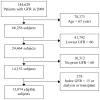Metabolic complications in elderly adults with chronic kidney disease
- PMID: 22283563
- PMCID: PMC3527008
- DOI: 10.1111/j.1532-5415.2011.03818.x
Metabolic complications in elderly adults with chronic kidney disease
Abstract
Objectives: To determine whether elderly adults with a low glomerular filtration rate (GFR) are at risk for anemia, hyperkalemia, acidosis, and hyperphosphatemia.
Design: Retrospective study.
Setting: Veterans Affairs Medical Center.
Participants: Thirteen thousand eight hundred seventy-four veterans aged 65 and older with chronic kidney disease (CKD) and a GFR between 15 and 60 mL/min per 1.73 m(2) . Their average age was 79.
Measurements: Anemia was defined as a hemoglobin level of less than 10 g/dL, hyperkalemia as a potassium level greater than 5.5 mEq/L, acidosis as a bicarbonate level of less than 21 mEq/L, and hyperphosphatemia as a phosphorus level greater than 4.6 mg/dL. Multivariable logistic regression was used to evaluate whether age modifies the effect of low GFR on metabolic complications by including an interaction term between age and GFR in each model.
Results: The average GFR of participants was 46.5 mL/min per 1.73 m(2) , 3.1% had anemia, 2.5% hyperkalemia, 2.3% acidosis, and 4.4% had hyperphosphatemia. Lower GFR was associated with higher rates of metabolic complications across all age groups (odds ratio per 5-mL/min per 1.73 m(2) decrease in GFR in multivariable models was 1.21 for anemia, 1.26 for hyperkalemia, 1.45 for acidosis, and 1.72 for hyperphosphatemia). There was no significant interaction between age and GFR in models including only age and GFR or in multivariable models (P-values for age by GFR interaction term: 0.66 for anemia, 0.19 for hyperkalemia, 0.54 for acidosis, and 0.22 for hyperphosphatemia).
Conclusion: Elderly adults with CKD are at risk for anemia, hyperkalemia, acidosis, and hyperphosphatemia; age does not modify the relationship between GFR and development of metabolic complications. Elderly adults with low GFR should be monitored for metabolic complications, regardless of age.
© 2012, Copyright the Authors Journal compilation © 2012, The American Geriatrics Society.
Conflict of interest statement
Figures
Comment in
-
Metabolic complications in elderly adults with CKD.Am J Kidney Dis. 2012 Dec;60(6):893-5. doi: 10.1053/j.ajkd.2012.06.008. Epub 2012 Jul 15. Am J Kidney Dis. 2012. PMID: 22800856 No abstract available.
-
Magnesium homeostasis and metabolic complications in elderly adults with chronic kidney disease.J Am Geriatr Soc. 2012 Sep;60(9):1794-5; author reply 1795. doi: 10.1111/j.1532-5415.2012.04130.x. J Am Geriatr Soc. 2012. PMID: 22985162 No abstract available.
References
-
- Coresh J, Selvin E, Stevens LA, et al. Prevalence of chronic kidney disease in the United States. JAMA. 2007;298:2038–2047. - PubMed
-
- K/DOQI clinical practice guidelines for chronic kidney disease: Evaluation, classification, and stratification. Am J Kidney Dis. 2002;39:S1–266. - PubMed
-
- Glassock RJ, Winearls C. An epidemic of chronic kidney disease: Fact or fiction? Nephrol Dial Transplant. 2008;23:1117–1121. - PubMed
-
- O’Hare AM, Choi AI, Bertenthal D, et al. Age affects outcomes in chronic kidney disease. J Am Soc Nephrol. 2007;18:2758–2765. - PubMed
Publication types
MeSH terms
Grants and funding
LinkOut - more resources
Full Text Sources
Medical



